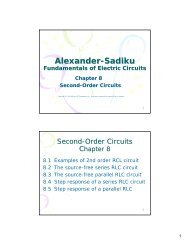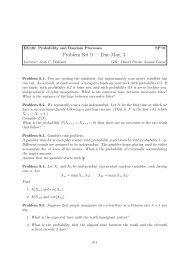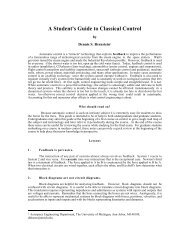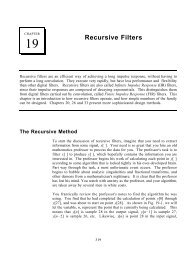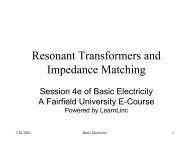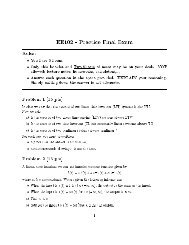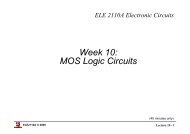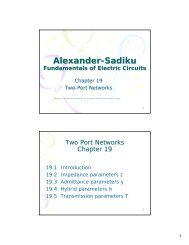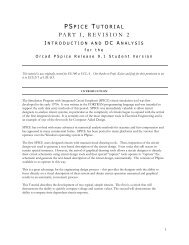Chapter 15 Alternating Current
Chapter 15 Alternating Current
Chapter 15 Alternating Current
Create successful ePaper yourself
Turn your PDF publications into a flip-book with our unique Google optimized e-Paper software.
<strong>Chapter</strong> <strong>15</strong><br />
AC Fundamentals<br />
<strong>Alternating</strong> <strong>Current</strong><br />
Voltages of ac sources alternate in<br />
polarity and vary in magnitude<br />
Voltages produce currents that vary in<br />
magnitude and alternate in direction<br />
2<br />
1
<strong>Alternating</strong> <strong>Current</strong><br />
A sinusoidal ac waveform starts at zero<br />
Increases to a positive maximum<br />
Decreases to zero<br />
Changes polarity<br />
Increases to a negative maximum<br />
Returns to zero<br />
Variation is called a cycle<br />
3<br />
Generating AC Voltages<br />
4<br />
2
Generating AC Voltages<br />
5<br />
AC Voltage-<strong>Current</strong> Conventions<br />
Assign a reference polarity for source<br />
When voltage has a positive value<br />
Its polarity is same as reference polarity<br />
When voltage is negative<br />
Its polarity is opposite that of the reference<br />
polarity<br />
6<br />
3
AC Voltage-<strong>Current</strong> Conventions<br />
Assign a reference direction for current<br />
that leaves source at positive reference<br />
polarity<br />
When current has a positive value<br />
Its actual direction is same as current<br />
reference arrow<br />
7<br />
AC Voltage-<strong>Current</strong> Conventions<br />
When current is negative<br />
Its actual direction is opposite that of current<br />
reference arrow<br />
8<br />
4
Frequency<br />
Number of cycles per second of a<br />
waveform<br />
Frequency<br />
Denoted by f<br />
Unit of frequency is hertz (Hz)<br />
1 Hz = 1 cycle per second<br />
9<br />
Period<br />
Period of a waveform<br />
Time it takes to complete one cycle<br />
Time is measured in seconds<br />
The period is the reciprocal of frequency<br />
T = 1/f<br />
10<br />
5
Amplitude and Peak-to-Peak Value<br />
Amplitude of a sine wave<br />
Distance from its average to its peak<br />
We use E m for amplitude<br />
Peak-to-peak voltage<br />
Measured between minimum and maximum<br />
peaks<br />
11<br />
We use E pp or V pp<br />
Peak Value<br />
Peak value of an ac voltage or current<br />
Maximum value with respect to zero<br />
If a sine wave is superimposed on a dc<br />
value<br />
Peak value of combined wave is sum of dc<br />
voltage and peak value of ac waveform<br />
amplitude<br />
12<br />
6
The Basic Sine Wave Equation<br />
Voltage produced by a generator is<br />
e = E m sin<br />
E m is maximum (peak) voltage<br />
is instantaneous angular position of<br />
rotating coil of the generator<br />
13<br />
The Basic Sine Wave Equation<br />
Voltage at angular position of sine wave<br />
generator<br />
May be found by multiplying E m times the sine<br />
of angle at that position<br />
14<br />
7
Angular Velocity<br />
Rate at which the generator coil rotates<br />
with respect to time, (Greek letter<br />
omega)<br />
<strong>15</strong><br />
Angular Velocity<br />
Units for are revolutions/second,<br />
degrees/sec, or radians/sec.<br />
t<br />
t<br />
16<br />
8
Radian Measure<br />
is usually expressed in radians/second<br />
2 radians = 360°<br />
To convert from degrees to radians,<br />
multiply by /180<br />
17<br />
Radian Measure<br />
To convert from radians to degrees,<br />
multiply by 180/<br />
When using a calculator<br />
Be sure it is set to radian mode when working<br />
with angles measured in radians<br />
18<br />
9
Relationship between ,T, and f<br />
One cycle of a sine wave may be<br />
represented by = 2 rads or t = T sec<br />
T<br />
t<br />
2<br />
2<br />
T<br />
2 f<br />
19<br />
Voltages and <strong>Current</strong>s as<br />
Functions of Time<br />
Since = t, the equation e = E m sin<br />
becomes e(t) = E m sin t<br />
Also, v(t) = V m sin t and i(t) = I m sin t<br />
20<br />
10
Voltages and <strong>Current</strong>s as<br />
Functions of Time<br />
Equations used to compute voltages and<br />
currents at any instant of time<br />
Referred to as instantaneous voltage or<br />
current<br />
21<br />
Voltages and <strong>Current</strong>s with<br />
Phase Shifts<br />
If a sine wave does not pass through zero<br />
at t = 0, it has a phase shift<br />
For a waveform shifted left<br />
v = V m sin( t + )<br />
For a waveform shifted right<br />
v = V m sin( t - )<br />
22<br />
11
Phasors<br />
Rotating vectors whose projection onto a<br />
vertical or horizontal axis can be used to<br />
represent sinusoidally varying quantities<br />
23<br />
Phasors<br />
A sinusoidal waveform<br />
Produced by plotting vertical projection of a<br />
phasor that rotates in the counterclockwise<br />
direction at a constant angular velocity<br />
24<br />
12
Phasors<br />
Phasors apply only to sinusoidally<br />
varying waveforms<br />
25<br />
Shifted Sine<br />
Waves<br />
Phasors used to<br />
represent shifted<br />
waveforms<br />
Angle is position<br />
of phasor at t = 0<br />
seconds<br />
26<br />
13
Phase Difference<br />
Phase difference is angular displacement<br />
between waveforms of same frequency<br />
If angular displacement is 0°<br />
Waveforms are in phase<br />
27<br />
Phase Difference<br />
If angular displacement is not 0 o , they are<br />
out of phase by amount of displacement<br />
28<br />
14
Phase Difference<br />
If v 1 = 5 sin(100t) and v 2 = 3 sin(100t -<br />
30° ), v 1 leads v 2 by 30°<br />
May be determined by drawing two waves<br />
as phasors<br />
Look to see which one is ahead of the other<br />
as they rotate in a counterclockwise direction<br />
29<br />
Average Value<br />
To find an average value of a waveform<br />
Divide area under waveform by length of its<br />
base<br />
Areas above axis are positive, areas<br />
below axis are negative<br />
30<br />
<strong>15</strong>
Average Value<br />
Average values also called dc values<br />
dc meters indicate average values rather than<br />
instantaneous values<br />
31<br />
Sine Wave Averages<br />
Average value of a sine wave over a<br />
complete cycle is zero<br />
Average over a half cycle is not zero<br />
32<br />
16
Sine Wave Averages<br />
Rectified full-wave average is 0.637 times<br />
the maximum value<br />
Rectified half-wave average is 0.318 times<br />
the maximum value<br />
33<br />
Effective Values<br />
Effective value or RMS value of an ac<br />
waveform is an equivalent dc value<br />
It tells how many volts or amps of dc that an ac<br />
waveform supplies in terms of its ability to<br />
produce the same average power<br />
34<br />
17
Effective Values<br />
In North America, house voltage is 120<br />
Vac.<br />
Voltage is capable of producing the same<br />
average power as a 120 V battery<br />
35<br />
Effective Values<br />
To determine effective power<br />
Set Power(dc) = Power(ac)<br />
P dc = p ac<br />
I 2 R = i 2 R where i = I m sin t<br />
By applying a trigonometric identity<br />
Able to solve for I in terms of I m<br />
36<br />
18
I eff = .707I m<br />
Effective Values<br />
V eff = .707V m<br />
Effective value is also known as the RMS<br />
value<br />
37<br />
19
This document was created with Win2PDF available at http://www.daneprairie.com.<br />
The unregistered version of Win2PDF is for evaluation or non-commercial use only.





